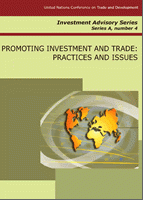
This report focuses on a very topical issue: institutional arrangements for investment and trade promotion.
The main rationale for creating institutions that promote investment as well as trade is that both functions have certain activities in common, most importantly the marketing of a country and its key industries. However, it may be argued that investment promotion differs so much from trade promotion that it is necessary to have separate institutions for the two functions.
Through a website review, this report shows that a majority (58 per cent) of the institutions promoting foreign investment at the national level do so exclusively, while 42 per cent also promote trade. The proportions of separate investment promotion agencies (IPAs) and combined agencies were quite similar for developed and developing countries. The website review further indicated that combined agencies were more common in smaller economies (measured in terms of gross domestic product). Integrating investment and trade promotion in a single agency could be a rational approach for smaller countries, where financial and human resources are often scarce and the need for international marketing is likely to be greater.
A follow-up survey was sent out to a sample of agencies to find answers to the question of why some countries have mergedinvestment and trade promotion while others have not. Cost efficiency and potential synergies – especially avoiding duplicationof work and enhancing marketing – tend to prevail as drivers for integration. For some of the agencies surveyed, it was too early to tell how successful the integration process had been, but the overall results were mixed. Examples of success factors in the creation of combined agencies are: identifying where synergies can be found and taking this as a point of departure for integration, adopting a gradual integration approach, and focusing promotion strategies on industries that are associated with export-related foreign direct investment (FDI).
There are also a number of arguments in favour of separate investment and trade promotion institutions. Many countries haveconsciously chosen to focus their IPA’s work exclusively on investment promotion, and in some of these cases, this had alsobeen recommended by independent evaluators. Investment and trade promotion require different skills, and staff work withdifferent clients that are often located in different countries.
Furthermore, trade promoters usually work within shorter time frames than practitioners in investment promotion, where client decisions are generally more strategy-based and aftercare is of growing importance. These and a number of other factors limitsynergies and the extent to which efficiency and greater impact can be achieved through an integrated approach.
Finally, evidence from some countries suggests that cost savings and synergies can be obtained to a certain extent even withseparate agencies, through collaboration arrangements in key areas. Whatever the circumstances, investment and trade promotionpractitioners should not work in “separate worlds”. Some common ground is likely to exist between them, and they may findpartnerships to be fruitful.


